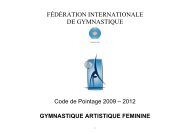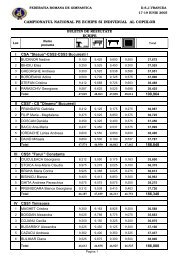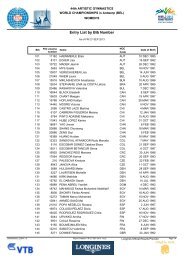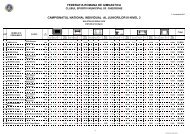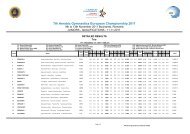REPORT Training Camp for Juniors Men's Artistic Gymnastics ...
REPORT Training Camp for Juniors Men's Artistic Gymnastics ...
REPORT Training Camp for Juniors Men's Artistic Gymnastics ...
You also want an ePaper? Increase the reach of your titles
YUMPU automatically turns print PDFs into web optimized ePapers that Google loves.
<strong>REPORT</strong><br />
<strong>Training</strong> <strong>Camp</strong> <strong>for</strong> <strong>Juniors</strong><br />
Men’s <strong>Artistic</strong> <strong>Gymnastics</strong><br />
Tirrenia, Italy - July 20 th to 30 th 2010<br />
1. Organisation of the training camp<br />
Participants: 30 gymnasts (13-16 years old, born between 1994-1997) and 22 coaches<br />
from AUT, CRO, CZE, FRA, GBR, GER, IRL, ISR, ITA, LUX, RUS, SUI, SWE and TUR.<br />
Dates: 20 - 30.07.2010.<br />
Venue: Olympic preparation Centre in Tirrenia, CONI;<br />
Responsible and representatives of the MTC/UEG : Jacob Wischnia (Vice-president<br />
MTC/UEG) and Mircea Dumitru Apolzan (member MTC/UEG).<br />
Gianfranco Marzolla (president MTC/UEG) and Tom Thingvold (member MTC/UEG) were<br />
present <strong>for</strong> the opening and stayed some days.<br />
Experts:<br />
- Valeri Belenky (GER), physical preparation, pommel horse, bars;<br />
- Fulvio Vailati (ITA), planning of the training, training systems;<br />
- Pierre Coponat (FRA), physical preparation, high bar, floor;<br />
- Diego Lazzarich (ITA), physical preparation, floor, rings;<br />
- Valentin Potapenko (FRA), physical preparation, floor ;<br />
- Rossana Bonzi (ITA), choreography, physical preparation;<br />
- Mircea Dumitru Apolzan (UEG), FIG/UEG Regulations.<br />
Organisers (Italian <strong>Gymnastics</strong> Federation):<br />
- Rino Scala (ITA) – administrative coordination of the training camp ;<br />
- Alberto Fornera (ITA) – assistant to the experts.<br />
The video recordings and the DVD <strong>for</strong> the training camps were realised by Robert Hirsch<br />
(GER).<br />
2. Objectives of the training camp<br />
- Exchange of experience between coaches;<br />
- Presentation of a modern training system <strong>for</strong> young gymnasts aged 13 to16 ;<br />
- To teach the importance of a professional and modern preparation <strong>for</strong> high level<br />
gymnastics at this age (13-16 years) ;<br />
- Development and progress of the basic elements and correct technical study of all<br />
apparatus ;<br />
- Theoretical training of the coaches with the help of presentations made by experts<br />
(selection in gymnastics, planning of the preparation, code of points FIG/UEG<br />
Regulations, etc.);<br />
- Creation of a European spirit in gymnastics by the joint work of coaches and gymnasts<br />
1
- To offer an attractive programme that at the same time includes free time and a<br />
cultural part (visit of Florence, Pisa, Luna Park etc.).<br />
3. Description of the camp programme<br />
Physical preparation<br />
Under the control of the coaches, the gymnasts per<strong>for</strong>med daily a physical<br />
preparation course.<br />
A team of coaches was responsible <strong>for</strong> the preparation of the daily programme,<br />
allowing the content of the exercises being changed regularly. This made it possible<br />
to avoid the typical monotony of the physical preparation, to increase the motivation<br />
of the gymnasts and to improve the experience of the coaches <strong>for</strong> this part of the<br />
training. The coaches have acted as “controllers” at the different points of the<br />
course but they have also kept an eye on the quality of the execution.<br />
The objective of the choreography part<br />
Aim of this preparation was the improvement of the flexibility of the gymnasts, the<br />
development of certain positions, the improvement of the general posture of the<br />
gymnasts during exercises accompanied by music. The gymnasts have worked all<br />
together under the direct and permanent control of the coaches.<br />
Despite a certain scepticism towards the role of choreography in men’s artistic<br />
gymnastics (an attitude that seems to disappear in the mentality of athletes and<br />
coaches), visible progresses were noted regarding the aspects of coordination,<br />
flexibility, and specific choreography<br />
The common conclusion of all coaches and gymnasts was the necessity to continue<br />
this kind of preparation.<br />
The gymnasts worked all together – the direct and permanent control of the<br />
coaches was a requirement expressed by the expert of the choreography.<br />
Rossana Bonzi, responsible <strong>for</strong> choreography, has successfully managed to<br />
capture the interest of the participants with exercises that mixed music with dance<br />
and the typical positions of MAG; the requirements <strong>for</strong> coordination capacities were<br />
very high.<br />
Small moments of choreography and dance <strong>for</strong> the relaxation of the<br />
gymnasts/coaches, and moments of “stretching” with music, have also brought<br />
some colours throughout the sometimes monotonous work in our sport<br />
Prevention of micro-traumas<br />
The exercises were per<strong>for</strong>med in groups, under the direct control of the coaches.<br />
Scheduled after the physical preparation, this part of the camp programme<br />
contained a series of exercises <strong>for</strong> the prevention of micro-traumas of the joints in<br />
arms and feet.<br />
Technical preparation<br />
Following the recommendations made by the coaches in previous courses, more<br />
time and importance was given to this part of the training. In accordance with the<br />
programme established by the organisers, the technical preparation was developed<br />
in the second part of the day. The work method was similar to the one of an “official<br />
podium training”, each group of gymnasts having a certain time on each apparatus<br />
under the direction of their own coaches.<br />
New this year was that all experts (each one on its apparatus) were involved in this<br />
chapter of the preparation by conducting the work of the gymnasts. They assisted<br />
the coaches and gymnasts in learning the basic elements and the more difficult<br />
elements.<br />
2
Practical presentation of the experts<br />
These presentations concerned the methods of learning the basic technical<br />
elements, the help (physical assistance) provided by coaches, auxiliary exercises,<br />
the use of support apparatus <strong>for</strong> learning the elements.<br />
The theoretical lectures<br />
They were held in the gymnastics hall; the gymnasts could also participate. The<br />
following presentations were made by the experts:<br />
- acrobatics on floor, rings - Diego Lazzarich<br />
- pommel horse, bars – Valery Belenky<br />
acrobatics on floor – Valentin Potapenko<br />
- high bar – Pierre Coponat<br />
Theoretical preparation<br />
Lectures on the following topics were held:<br />
- Choreographic preparation (Rossana Bonzi) ; her presentation (video)<br />
focused on elements of the choreographic preparation <strong>for</strong> beginners<br />
- <strong>Training</strong> planning and training systems (Fulvio Vailati); his presentation<br />
concerned the athletes’ selection and the planning of the preparation and the<br />
participation in competitions, <strong>for</strong> juniors and seniors;<br />
- Acrobatic preparation (Diego Lazzarich); he presented statistics on the<br />
acrobatic elements presented during the last World and European<br />
Championships, as well as on the scores obtained by the gymnasts;<br />
- Presentation of the novelties in the FIG/UEG regulations (Mircea Dumitru<br />
Apolzan); the content of the presentation focused on the most important<br />
changes of the code of points (particularly the ones of the last edition of the<br />
code/version 6), the concept of the reference judges, the new tasks of the<br />
supervisors.<br />
4. Conclusions and assessments by the coaches<br />
As every year, a meeting was organised at the end of the camp during which the<br />
organisers and coaches have exchanged impressions regarding the running of this camp.<br />
Furthermore they have expressed suggestions and opinions regarding specific technical<br />
and practical elements. Among these, the following ones can be mentioned:<br />
- the organisers, experts and coaches have <strong>for</strong>med an homogeneous, well united team<br />
all along the camp’s duration;<br />
- all participants have expressed their satisfaction to participate in this kind of event,<br />
where the practical part can be mixed with the theoretical presentations.<br />
- more assistance from the experts <strong>for</strong> the training sessions (technical preparation),<br />
especially <strong>for</strong> the most difficult elements and even <strong>for</strong> the basic elements ;<br />
- the theoretical preparation can take place sooner than indicated in the programme of<br />
the organisers (be<strong>for</strong>e 21h00) ;<br />
5. Conditions of accommodation, training and theoretical <strong>for</strong>mation<br />
All participants have well appreciated all facilities provided by the Olympic Preparation<br />
Centre CONI, Tirrenia. Compared to previous years, the organisers have made many<br />
ef<strong>for</strong>ts to improve the conditions.<br />
First, the training hall, rebuilt on the same site as the old one, is now equipped with the<br />
latest generation of apparatus « Janssen & Fritsen » and presents itself in other conditions<br />
than the last years. We can now per<strong>for</strong>m all choreographic lessons in the same hall, the<br />
physical preparation and practical lessons at the same place saving time.<br />
3
Of course, there are small details which the organisers will resolve <strong>for</strong> the future<br />
(installation of air conditioning, pits, plat<strong>for</strong>ms <strong>for</strong> the assistance at the apparatus, etc.), but<br />
in any case the training conditions have visibly improved.<br />
6. Recommendations <strong>for</strong> the future camps<br />
- it would be very good to have the possibility to work with the same group of experts in<br />
future UEG camps;<br />
- find other subjects <strong>for</strong> the theoretical lessons;<br />
- other national European federations should be stimulated to participate with coaches<br />
and gymnasts, etc.<br />
Thanks<br />
Sincere thanks from all participants of the camp were addressed to the Italian <strong>Gymnastics</strong><br />
Federation <strong>for</strong> the organization and to the International <strong>Gymnastics</strong> Federation <strong>for</strong> its<br />
financial support. A big thank you to the director of the CONI Tirrenia, and to the staff of<br />
the centre.<br />
We cannot finish this report without remembering Claus Haller who had organised these<br />
training camps in the last years; we cannot <strong>for</strong>get his devotion, commitment and<br />
determination <strong>for</strong> the success of this important event <strong>for</strong> the European gymnastics.<br />
Un<strong>for</strong>tunately, he is no longer with us. Thank you, Claus.<br />
Jacob WISCHNIA<br />
Vice-president MTC/UEG<br />
Mircea Dumitru Apolzan<br />
Member MTC/UEG<br />
4



